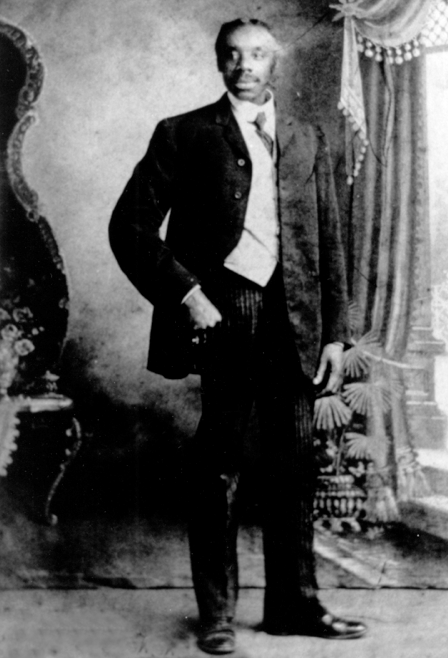George Washington Thomas was born in Wisemantown, Kentucky, around 1860 or 1861. At that time Kentucky was still a slave state but there are no records that indicate George was born into slavery. He was the first child of Samuel and Lisa (Bell) Thomas. He had four sisters (Mary, Luella, Effie, and Grace) and one brother (Everett). In 1884 Samuel and Lisa moved their family to Normal, Illinois where Samuel worked as a blacksmith. Their home was located at 113 W. Willow Street which would remain George’s home for the rest of his life. Although there is no reason recorded as to why the family traveled to Normal, it could have been because of the opportunity for land and work. “Crop failures, economic hardships, and the failures of Reconstruction stimulated a Great Migration of southern blacks to northern cities at the end of the nineteenth century.” In addition, Jesse Fell, who founded the town of Normal, encouraged black settlement in the area. He helped find jobs for African Americans who came to Normal.
At a young age George learned the trade of blacksmithing from his father. He first worked at the blacksmith shop of Henry W. Goff located on North Linden Street in Normal. He began working there in about 1891. He repaired wagons and buggy wheels, shoed horses, sharpened farm tools, welded, and helped run the business. After working for Goff for over 10 years, George and his brother Everett partnered together and operated their own blacksmith shop. It is possible that they took over as owner/operators of Goff’s blacksmith shop as the address of George’s shop was also on North Linden Street in Normal (which today is the location of the Town of Normal water plant). The business ran from around 1904 to 1934.
In the early 1900s there were far more horses than automobiles allowing a blacksmith to run a booming business. Although there are no personal accounts left from Thomas about his blacksmithing or the different jobs he would perform, his routine was probably similar to any other blacksmith at the time. The tools and equipment that were generally used were: a forge (a hearth for heating metals to a malleable temperature making them easier to shape), an anvil (the object on which the hot metal is struck in order to shape it), bellows (an accordion shaped pump used to add draft to fuel the fire in the forge), hammer, tongs (used to transport hot metals from the forge to the anvil), wrenches, nails, and a buckskin apron. In order to heat the forge, coal was used and the bellows would stoke the fire to make it hot enough to heat the metal items which they were working with. The most common item blacksmiths would make were shoes for horses. The blacksmith first trimmed the horse’s hooves “so the shoe would fit. The shoe was then heated in the forge, removed with the tongs, and hammered on the anvil. The last step was nailing the shoe” to the horse’s hoof. Each horse would take about fifteen minutes to shoe and a blacksmith could shoe on average about 14 to 17 horses per day. The average charge was $.50 to $.75 per job. Today that would be around $13.00 to $20.00. In addition to tending to the needs of animals, household items and farm equipment were also made in a blacksmith shop. The blades of plows and cultivators were sharpened and wagon wheels and tire repairs were also preformed.
The work of a black smith would generally begin in the early morning because the heat of the forge combined with the heat on the roof of the shop would make it almost unbearable to work in the afternoon. Injuries were not uncommon in this trade and many hours were spent bent over an anvil that a blacksmith might find it hard to stand up straight at the end of the day.
Known as “Wash,” to the community, George stood about 6’1” and was all muscle. He wore a trademark leather blacksmith’s cap and leather apron over his bib overalls. Many members of the community recall being in awe of a “large black man in an heavy leather apron.” As children walked to school, they passed the shop and would see George “squatting down with a horse hoof over his knee.” He spent five or more days working in his blacksmith shop every week.
He married Amanda Merrill in December of 1907 and they resided at the Thomas family home located at 113 W. Willow St. in Normal. They had a large barn which they converted into a double car garage and apartment later in life. Right next door to their home was the home of George’s brother Everett. George and Amanda had no children of their own. Instead, they opened their home and boarded African American students who attended Illinois State Normal University. The students affectionately called the two, G.W. and Mrs. G.W.
George Washington Thomas was considered one of the wealthier men of color in McLean County and was held in high regard by members of the community. George and his wife were members of Bethel African Methodist Episcopal Church in Normal. The church was located on the north-west corner of Locust Street and Fell Avenue and was founded in the 1890s. George served on the Board of Stewards for many years and was also the secretary of the board from 1901-1902. His wife was also a social person. She was a church stewardess at Bethel A.M.E., a member of the Three C’s Club, and the Progressive Women’s Social Club.
After over 50 years of blacksmithing, Thomas retired from his shop several years before he died December 17, 1946. He was preceded in death by his wife Amanda who passed away the year before his death. Both are buried at Evergreen Memorial Cemetery in Bloomington, IL.
